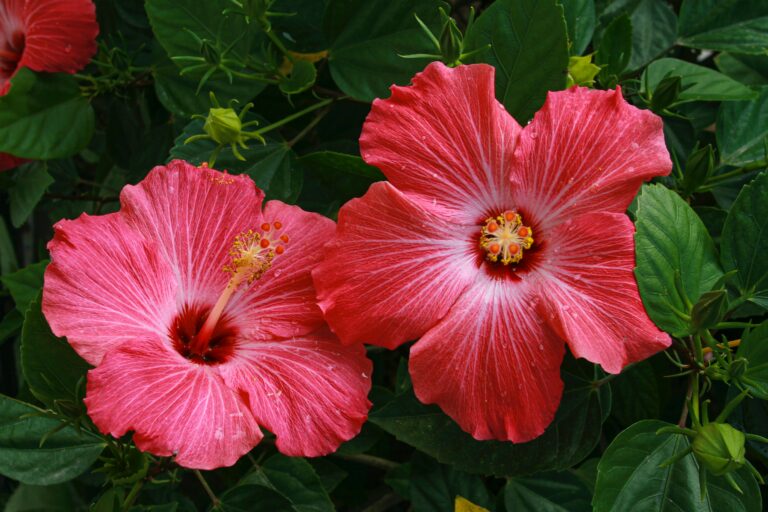Tropical hibiscus, also known as Hawaiian hibiscus or China rose, is a stunning tropical plant that is (just like the Elephant ear plant) native to the Pacific and Southeast Asia. With its large, brightly colored flowers, it is a popular choice for outdoor gardens in warm climates, as well as indoor spaces. It is a relatively slow-growing shrub, typically reaching 4-6 feet tall and wide.
This beautiful plant requires plenty of sunlight and well-draining soil to thrive and should be protected from strong winds to prevent damage.
The most popular hibiscus varieties include:
- ‘Yellow Hibiscus’
- ‘Blue River’
- ‘Dainty Doll’
- ‘Double Yellow’
- ‘Starburst’
- ‘Green Hibiscus’
- ‘Samantha’
Propagation
You can propagate Tropical Hibiscus plants easily through stem cuttings. Just choose a healthy stem that is about 6 inches long and has several leaves. Remove the bottom leaves, dip the cut end into the rooting hormone, and then plant it in well-draining soil. Keep the soil moist and provide bright, indirect light until roots have formed and new growth appears, usually within a few weeks.
Care
Tropical hibiscus plants can thrive in warm climates as a perennial garden plant and are used as shrubs for hedging and screening. In cooler climates, they are commonly grown in large containers as a patio or deck decoration. They are not very hard to care for, just pay attention to these requirements:
- Soil: Tropical hibiscus plants thrive in well-draining soil, either a potting mix for tropical plants or soil with lots of organic matter. To avoid root rot, ensure that the soil drains well in both container and ground locations.
- Water: Tropical hibiscus requires plenty of water to thrive and produce blooms. The frequency of watering may vary based on local climate conditions and may need to be done daily or even twice a day during dry spells.
- Light: This beautiful plant thrives in full sun but may prefer partial shade in hot and dry areas. To encourage flowering, place the plant in a location with more sunlight. If your Hibiscus plant consistently produces flowers, it is definitely happy.
- Temperature: They are sensitive to cold weather and should be protected from temperatures below 50 degrees Fahrenheit. If a cold front is approaching, just move the plant indoors. The ideal temperature range for tropical hibiscus is between 55 and 70 degrees Fahrenheit.
Pruning
Pruning hibiscus is very important if you want your plant to stay healthy and keep blooming. As far a the right timing goes, it depends on your location. In general, spring is the ideal time for hibiscus pruning, avoiding the dormant late fall or winter periods.
If you delay pruning too much, it can lead to fewer branches and blooms. For the best results, it’s better to prune dead or weak growth during the early spring when new growth begins. This complete cutting back helps rejuvenate the plant for summer blooming.
Using sharp, clean shears, cut about a third of the way back, above the nodes, leaving two to three nodes on the branches for new growth. Remove weak, diseased, or crossing branches and provide extra fertilizer for better blooms as the temperature warms up in late spring.
Common Pests
Frequently Asked Questions
Tropical hibiscus plants should be kept in a well-draining soil mix, placed in bright sunlight or partial shade and watered regularly (1-2 inches per week) to encourage blooming. The plant also prefers temperatures between 55-70°F.
What is the difference between hibiscus and tropical hibiscus?
Hibiscus is a large genus of plants that contains many different species, while tropical hibiscus refers specifically to the species Hibiscus rosa-sinensis, which is native to tropical regions. Tropical hibiscus is known for its large, brightly colored flowers and is commonly used as an ornamental plant, while other species of hibiscus have different characteristics and uses.
How big do tropical hibiscus get?
Tropical hibiscus plants can grow anywhere from 4 to 10 feet tall, depending on the variety and growing conditions.
Do hibiscus lose their leaves in winter?
Tropical hibiscus plants, which are native to warm, humid environments, are typically grown as annuals or perennials in temperate climates. In these conditions, they may lose their leaves in winter or during periods of dormancy.
Can tropical hibiscus survive the winter?
Tropical hibiscus can survive winter if they are protected from frost and extremely low temperatures. If temperatures are expected to fall below 50°F, it’s best to bring the plant indoors and keep it in a warm location.
